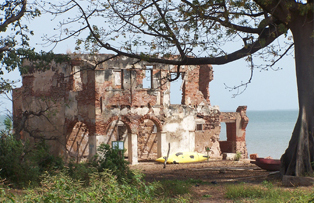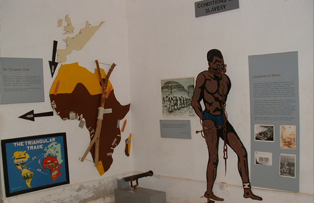

The first British traders in the Gambia came in 1587. They began to explore the river in 1618 and eventually got control of St. Andrew’s Island 1661. It was renamed James Island after the Duke of York, later King James II, and has now been renamed Kunta . Trading companies were set up and they tried to control the trade of the river.
By the mid-seventeenth century, the slave trade had over-shadowed all other trade. The British and French competed for the control of the area’s trade. In 1765, the forts and settlements were vested in the British crown and for eighteen years what is now The Gambia formed part of the British colony of Senegambia, with its headquarters in St. Louis at the mouth of the River Senegal. However in 1783, the greater part of the Senegambia region was handed to France and the Gambian section ceased to be a British colony, being placed once more in the charge of the African Company.

With the British abolition of the slave trade in their settlements in 1807, they tried to look for a suitable location in The Gambia from where they would be able to monitor the river and stop ships from entering and leaving with slaves. Alexander Grant, sent out from Goree for this purpose, found the fort at Kunta Kinteh Island to be too far inland and in ruins. He therefore entered into a treaty with the Chief of Kombo in April, 1816 for the cessation of the detached sand bank known as St. Mary’s Island. Originally called Banjulo by the Portuguese, Grant named the new settlement, Bathurst after the Colonial Secretary of the time Lord Bathurst. Britain declared the Gambia River a British Protectorate in 1820.
In 1886, Gambia became a crown colony, and the following year France and Britain drew the boundaries between Senegal (by then a French colony) and The Gambia. With the slave trade at an end, the British were forced to come up with a new source of wealth to support the fledgling protectorate, which led to the planting of groundnuts. The groundnuts or peanuts are originally from South America and were introduced to West Africa (first the Senegambia area) by the Portuguese in the 16th century. The harvested nuts are crushed to make oil, which is exported to Europe for use in food manufacture.
In the 1950s, Gambia’s groundnut production was beefed up as a way to increase export earnings and make the country that much more self supportive. Today groundnuts remain the chief crop of both The Gambia and neighboring Senegal. On the 18th of February 1965, The Gambia gained political independence from Britain and Britain’s Queen Elizabeth II remained as titular head of state. It was strongly felt that The Gambia would not be able to stand on her own and there were talks of forming a federation with Senegal, but this did not materialize at the time. Around the same time, two events occurred that enabled the tiny nation to survive and even prosper. For a decade after independence, the world price for groundnuts increased significantly, raising the country’s GNP almost threefold. The second event had an even more resounding effect – The Gambia became a significant tourist destination.
On April 24, 1970, The Gambia became a Republic following a majority approved referendum led by President Dawda Kairaba Jawara, who was re-elected five times. The relative stability of the Jawara era was broken first in a violent coup attempt in 1981 which was led by Kukoi Samba Sanyang, who, on two occasions, had unsuccessfully sought election to parliament. After a week of violence, which left several hundred dead, Jawara, who was in London when the attack began, appealed to Senegal for help. Senegalese troops defeated the rebel force. In the aftermath of the attempted coup, Senegal and The Gambia signed the 1982 Treaty of Confederation. The result, the Senegambia Confederation, aimed eventually to combine the armed forces of the two nations and unify economies and currencies. The Gambia withdrew from the con-federation in 1989. A protest by soldiers over late salaries in July 1994 turned into a coup d’état, led by a young lieutenant, Yahya Jammeh, A new military government was formed and in 1996 Elections were held and Lieutenant Jammeh was elected by popular vote by the people and a new constitution was introduced, ushering in the Second Republic. President Jammeh has since won two consecutive elections in 2001 and 2006 and re-mains in power to this day. He has brought stability to the country and tourism is back in a big way. Also the Gambian infrastructure has vastly improved, as is evidenced by the modern Banjul International Airport, new hospitals, roads and street lighting that are all being put in place.